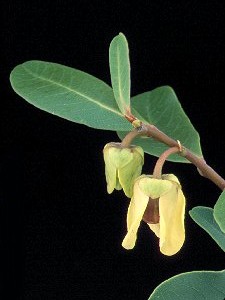Papau
| Papau | ||||||||||||
|---|---|---|---|---|---|---|---|---|---|---|---|---|

Asimina tetramera |
||||||||||||
| Systematics | ||||||||||||
|
||||||||||||
| Scientific name | ||||||||||||
| Asimina | ||||||||||||
| Adans. |
Pawpaw ( Asimina ), often incorrectly under the English name Pawpaw marketed, is a plant genus in the family of annonaceous (Annonaceae). The eight or so species thrive in forests and thickets in subtropical and temperate regions of North America .
The fruits of the Asimina species are edible, but so far they have only been specifically cultivated to a limited extent.
description



Vegetative characteristics
Asimina species grow as shrubs or small to medium-sized trees and, depending on the species, reach heights of 2 to 12 meters. The hardy three-lobed papau ( Asimina triloba ), which is common to the north, is deciduous, the other species, which are distributed further south, are predominantly evergreen.
The entire, simple and short-stalked leaves are alternate. With a length of 20 to 35 centimeters and a width of 10 to 15 centimeters, the leaf blades are lanceolate, elliptical to obovate and they are glabrous to slightly hairy. At the top they are pointed or rounded or tailed. The nerve is pinnate.
Generative characteristics
The one to eight flowers per axilla are 4 to 6 centimeters in size. The three- to four-fold, stalked flowers with a double inflorescence and calyx and petals arranged like a roof tile are white, yellow to purple or red-brown, depending on the species. The petals are arranged in two circles. They spread a pleasant or an unpleasant smell, which is said to attract flies and other scavenging insects, which are responsible for the spread of pollen. There are many stamens and three or more upper and hairy, approximated pistils , each sitting on the hemispherical flower base .
The fruits are edible, cylindrical and oblong or egg-shaped berries , they can be 5 to 16 centimeters long, 3 to 7 centimeters wide and 20 to 500 grams in weight. They have three to five seeds and appear in groups of three to five per flower on the flower base. The unripe fruits are green, the ripe yellow to brown. The taste is somewhat similar to that of bananas and mangoes. The fruits contain a relatively high amount of protein. The ellipsoidal and flattened seeds are brownish.
Systematics and distribution
The original home of the Papau species is on the North American continent. Of the eight species of the genus Asimina , all except Asimina parviflora and the three-lobed papau ( Asimina triloba ) are restricted to Florida and southern areas of Alabama and Georgia (Callaway 1990). Asimina parviflora grows throughout the southeastern part of the United States , while the three-lobed papau ( Asimina triloba ) is common in the east to southern Canada .
About eight species belong to this genus:
- Asimina incana (W.Bartram) Exell : It occurs in Florida and Georgia.
-
Asimina longifolia kraal : It is found in Alabama, Florida and Georgia. With the varieties:
- Asimina longifolia var. Longifolia
- Asimina longifolia var. Spatulata Kral
- Asimina obovata (Willdenow) Nash : This endemic is only found in Florida.
- Asimina parviflora (Michaux) Dunal : It is found in Alabama, Arkansas, Florida, Georgia, Louisiana, Mississippi, North Carolina, South Carolina, Tennessee, Virginia and Texas.
- Asimina pygmaea (W.Bartram) Dunal : It occurs in Georgia and Florida.
- Asimina reticulata Shuttleworth ex Chapman : This endemic occurs only in Florida.
- Asimina tetramera Small : This endemic occurs only in Florida.
- Three-lobed papau ( Asimina triloba (L.) Dunal ): It is found in Ontario and in the central and eastern United States.
There is also the hybrid Asimina × nashii , a cross of Asimina speciosa × Asimina longifolia .
swell
literature
- ME Bakker: Annonaceae: Genera Worldwide. Bln: Springer, 2000, ISBN 3540147047 .
Individual evidence
- ↑ a b c d e f g h Asimina in the Germplasm Resources Information Network (GRIN), USDA , ARS , National Genetic Resources Program. National Germplasm Resources Laboratory, Beltsville, Maryland. Retrieved June 8, 2018.
Web links
- PawPaw information (including variety overview and care)
- Description and diseases
- Robert Kral: Asimina Adanson - online with the same text as the printed work , In: Flora of North America Editorial Committee (ed.): Flora of North America North of Mexico. Volume 3: Magnoliophyta: Magnoliidae and Hamamelidae. Oxford University Press, New York and Oxford, 1997, ISBN 0-19-511246-6 .
- Asimina at Tropicos.org. Missouri Botanical Garden, St. Louis, Retrieved June 8, 2018.

